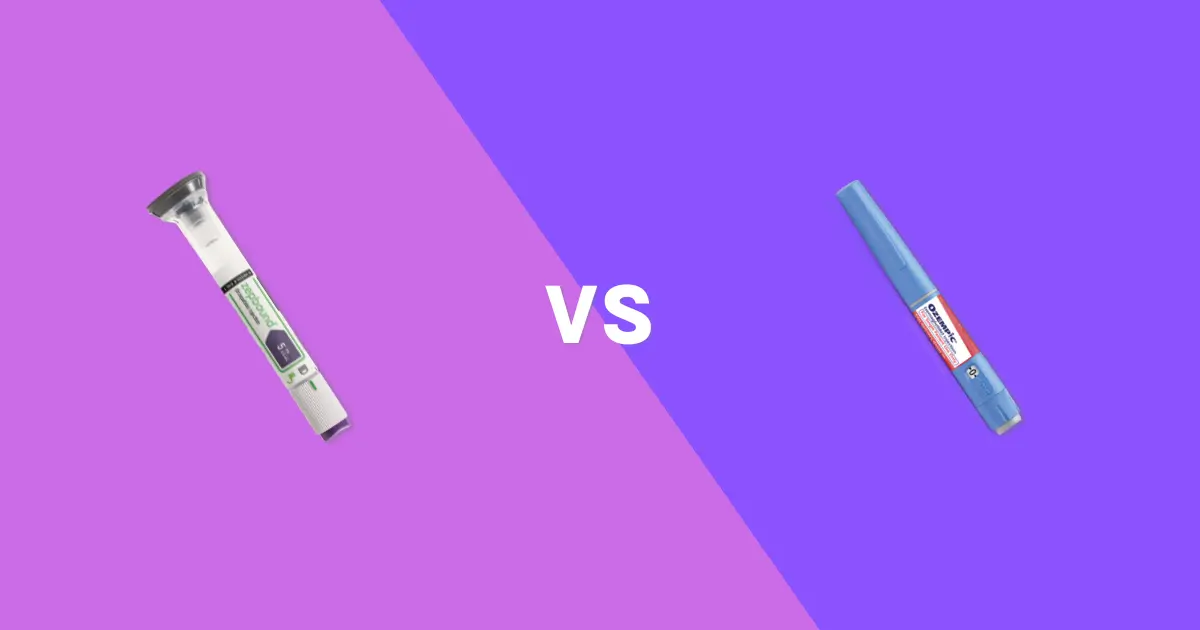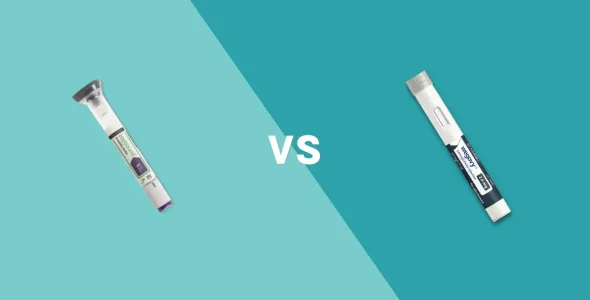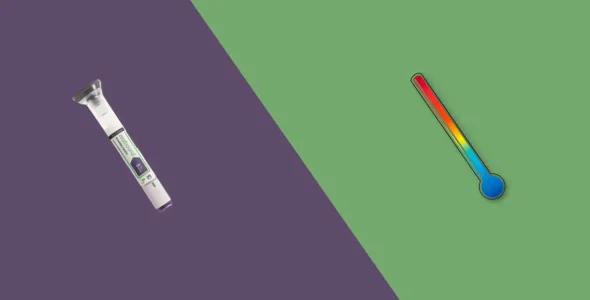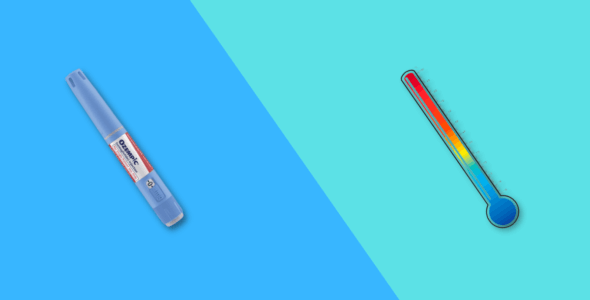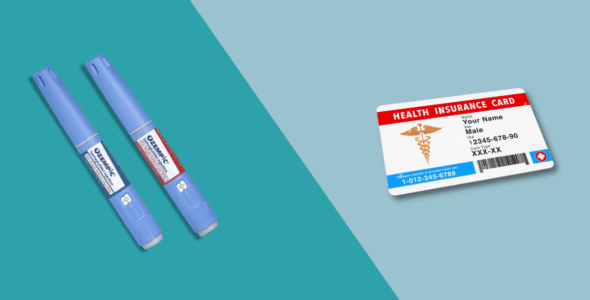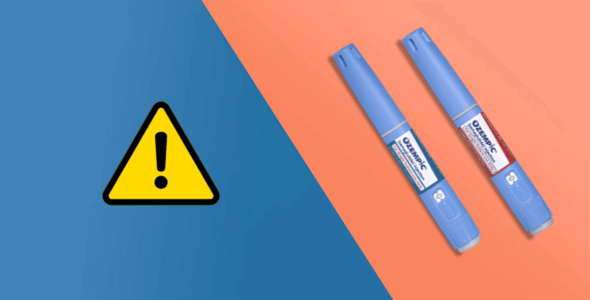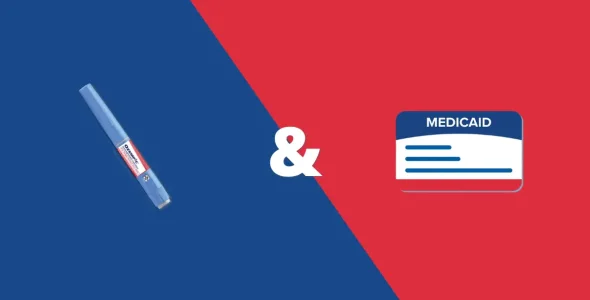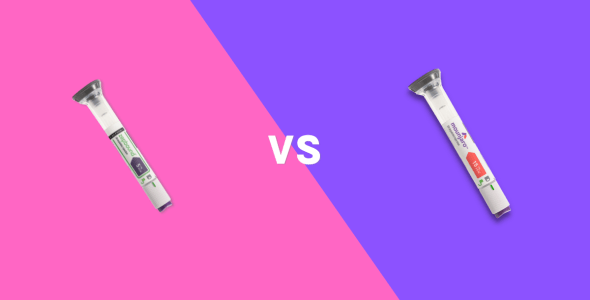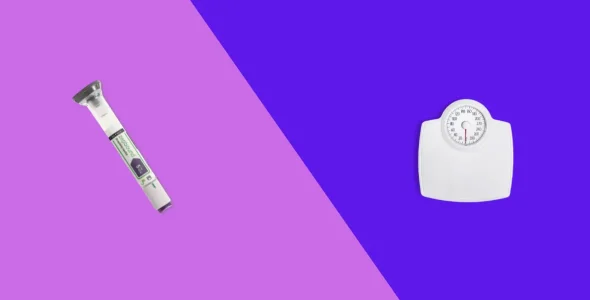Zepbound vs. Ozempic: what’s the difference?
Key highlights
- Zepbound (tirzepatide) is an FDA-approved weight loss drug, whereas Ozempic (semaglutide) is primarily prescribed for type-2 diabetes management. Besides a similar mechanism of action and being injected once weekly, Zepbound and Ozempic differ in their active ingredient, efficacy, dosage strength, insurance coverage, and weight loss benefits.
- Zepbound is available in 2.5 mg, 5 mg, 7.5 mg, 10 mg, 12.5 mg and 15 mg dosage strengths. Ozempic is available in 0.25 mg, 0.5 mg, 1 mg, and 2 mg dosage strengths.
- Zepbound shows better results in weight loss management than Ozempic.
- Ozempic has certain cardiovascular benefits while similar benefits for Zepbound haven’t been confirmed yet.
- Zepbound and Ozempic are not approved in patients with type-1 diabetes or cosmetic weight loss.
- Zepound is a weight loss drug and may not be covered by your insurance, whereas Ozempic may be covered by your insurance if prescribed for type 2 diabetes.
Zepbound (tirzepatide) and Ozempic (semaglutide) are incretin mimetics known to provide health benefits for weight loss, reduced blood sugar levels, obstructive sleep apnea and chronic kidney disease.
While both drugs work similarly, they are not the same. Ozempic is approved for patients with type 2 diabetes and Zepbound is approved for weight loss.
In this article, we will cover the main differences between Zepbound and Ozempic, including their efficacy, cost, side effects, weight loss benefits, and more.
What is Zepbound?
Zepbound (tirzepatide) by Eli Lilly is prescribed for weight loss in patients with obesity or overweight with other health conditions. This drug acts on the GLP-1 receptors and glucose-dependent insulinotropic polypeptide (GIP) to slow down metabolism. It also increases the transit time of food in the intestine which offers the feeling of being full for longer causing patients taking Zepbound to feel less hungry even when eating smaller portions.
Zepbound is prescribed to individuals with:
- A body mass index (BMI) of 30 or higher
- A body mass index (BMI) of 27 or higher with at least one weight-related health condition like type 2 diabetes, high blood pressure, heart disease, high cholesterol, or obstructive sleep apnea
What is Ozempic?
Ozempic (semaglutide) is a glucagon-like peptide-1 (GLP-1) agonist by Novo Nordisk recommended to manage glucose levels in type-2 diabetes. However, Ozempic and Wegovy (semaglutide) have been used as a weight loss drug for years before the Food and Drug Administration approved Zepbound for weight management.
Like Zepbound, this medicine also targets the GLP-1 receptors to lower blood sugar. Moreover, Ozempic also slows down digestion and makes you feel fuller to decrease appetite, which helps reduce weight.
Ozempic is prescribed to:
- Adults with type-2 diabetes (along with lifestyle changes and diet management)
- Reduce the risk of stroke or heart in adults with type-2 diabetes with known heart diseases
What are Zepbound and Ozempic used for?
While Ozempic is approved for type 2 diabetes and Zepbound is approved for weight loss, both drugs are commonly prescribed to patients as weight loss medications. They act on glucagon-like peptide 1 (GLP-1), inhibiting glucagon secretion and boosting glucose-induced insulin secretion. Thus, these medications lower blood sugar and delay digestion in obese and diabetic individuals.
Though individuals have been using these medicines for type-2 diabetes and weight loss, they’re often confused and wonder, “which one is better?”
Keep reading to learn all the differences between Zepbound and Ozempic in weight loss and more.
What are the main differences between Zepbound and Ozempic?
1. Different approved uses
Despite the use of Zepbound and Ozempic as weight loss drugs, it must be considered that Ozempic is not FDA-approved for weight loss. Ozempic has been used as a supplement for weight loss since people reported weight loss benefits while taking the medication. As such, Ozempic has been commonly prescribed off-label for weight loss and Zepbound is FDA-approved for weight loss.
2. Slightly different mechanism of action
While both medicines mimic incretins to regulate blood sugar and delay digestion, they do not work exactly the same way.
Ozempic mimics one incretin called the glucagon-like peptide-1 (GLP-1) agonist. At the same time, Zepbound works by mimicking two incretins: GLP-1 receptor agonist and glucose-dependent insulinotropic polypeptide (GIP). GIP is considered to work together with GLP-1 to have a greater effect than GIP alone.
3. Zepbound is better than Ozempic for weight loss
Zepbound’s active ingredient, tirzepatide, has been proven more effective in weight loss than Ozempic (semaglutide).
Semaglutide and tirzepatide weight loss benefits were compared in people with Type 2 diabetes. During a 40-week clinical trial, tirzepatide 15 mg (the highest dose) resulted in an average weight loss of around 25 lbs. In comparison, semaglutide 1 mg resulted in an average weight loss of 12.5 lbs. Unfortunately, the highest dose of Ozempic (2 mg) wasn’t evaluated in the study, however, it has been shown in other studies to result in an average weight loss of 15 lbs.
Semaglutide and tirzepatide are currently being compared in a separate clinical study for weight loss in people without diabetes which is expected to be completed by the end of 2024.
4. Cardiovascular benefits
Ozempic has shown cardio-protective effects in people with type 2 diabetes; it is often prescribed in diabetic patients with heart diseases to reduce the risk of stroke and heart attack. Though there is no such evidence of the cardiovascular effects of Zepbound, a phase 3 trial on the subject is expected to be completed in 2027.
5. Dosage strength
Zepbound has six dosage strengths: 2.5 mg, 5 mg, 7.5 mg, 10 mg, 12.5 mg, and 15 mg.
Ozempic has four dosage strengths: 0.25 mg, 0.5 mg, 1 mg, and 2 mg.
6. Administration
Zepbound by Eli Lilly comes in prefilled single-dose pens that you must insert subcutaneously into the skin. You need to discard the pen after using it as they are single-use only. The needle is already attached to the pen.
In contrast, Ozempic by Novo Nordisk injections are multiple-use, and you must change the needle every time.
After using the Ozempic pens for the first time, you can store the pens in the refrigerator (between 36°F-46°F) or at a controlled room temperature (between 59°F to 86°F) for up to 56 days.
As Zepbound pens are only used one time, you do not need to worry about storing the pens after each use. Zepbound pens will last until their expiration date when stored in the fridge (between 36°F-46°F) and you can keep them at a controlled room temperature for up to 21 days (to 86°F).
7. Insurance coverage
Zepbound is a weight loss drug and most likely will not be covered by your insurance plan, including Medicare. Most insurance plans do not cover weight loss drugs so it is recommended to speak to your insurance provider or check the formulary to verify if weight loss drugs including Zepbound are covered.
In contrast, Ozempic is covered by most insurance plans if prescribed for its approved use, type 2 diabetes. A prior authorization may be required by your insurance company before coverage is approved, and you may be required to try other medications for type 2 diabetes first.
Is Zepbound the same as Mounjaro?
No, Zepbound is not the same as Mounjaro. However, Zepbound and Mounjaro are brand names for the same drug, tirzepatide, while Zepbound is FDA-approved for chronic weight loss management and Mounjaro is FDA-approved for type 2 diabetes. Both drugs are manufactured by Eli Lilly.
Zepbound vs Ozempic dosage
Zepbound and Ozempic are once-weekly injections. Despite a similar dose frequency and mechanism of action, they come in different weekly dosage injections.
Zepbound is available in 2.5 mg, 5 mg, 7.5 mg, 10 mg, 12.5 mg and 15 mg dosage strengths. Ozempic is available in 0.25 mg, 0.5 mg, 1 mg, and 2 mg dosage strengths.
Zepbound dosing
Typically, doctors recommend starting with 2.5mg once every week and increasing the dose to 5mg weekly after 4 weeks. The manufacturer’s recommended maintenance doses are 5 mg, 10 mg, or 15 mg once weekly. The maximum dosage is 15 mg once weekly. It should be administered subcutaneously in your thigh, stomach, or the back of your upper arm.
Ozempic dosing
Ozempic is injected once weekly with a starting dose of 0.25 mg every week for four weeks. Your doctor will increase the dose to 0.5 mg per week for at least four weeks; you must only use pens that deliver 0.25 mg or 0.5 mg. Your healthcare provider might increase the dose to 1 mg or 2 mg gradually if you need additional blood sugar control. This medication should be administered subcutaneously in your thigh, stomach, or the back of your upper arm.
Zepbound vs Ozempic side effects
Ozempic and Zepbound’s side effects are quite similar, including common gastric-related side effects like:
- vomiting
- nausea
- diarrhea
- constipation
- abdominal pain
- heartburn
These side effects usually occur when you start the medicine or change dosage and subside as your body adjusts to the new dose.
Furthermore, the use of these medicines may result in serious side effects like gallbladder and pancreatic disease. Some people also report severe allergic reactions when taking Zepbound and Ozempic; it could happen when you are allergic to the active ingredient or any other component. You must immediately report serious side effects to your doctor.
These drugs also have a tumor risk black box warning as they can possibly cause thyroid tumors. Though there is no clinical evidence of cancer in humans, it has been reported during animal trials. Thus, Zepbound and Ozempic are not prescribed to people with (or a family history of) the following:
- Medullary thyroid cancer
- Multiple Endocrine Neoplasia syndrome type 2
Zepbound side effects
Besides the common side effects of Zepbound mentioned above, it can also cause the following:
- Injection site reactions
- Fatigue
- Belching
- Hair loss
- Hypoglycemia
- Vision changes
- Rash & breathing issues (signs of allergic reaction)
- Kidney problems
- Gallbladder issues
- Pancreatitis
Ozempic side effects
Ozempic and Zepbound share similar side effects. Some common side effects of Ozempic are:
- Blurred vision
- Bloating
- Flatulence
- Anorexia
- Belching
- Excessive urination
- Tachycardia
- Stomach inflammation
- Hypoglycemia
Which has less side effects, Ozempic or Zepbound?
Ozempic and Zepbound have similar side effects, including GI-related side effects, hypoglycemia, injection site reactions, belching, and possible allergic reactions. However, some issues like hair loss, fatigue, kidney problems, and depression are reported more frequently in Zepbound. At the same time, using Ozempic has been related to excessive urination, anorexia, flatulence, and tachycardia, which are less common in Zepbound users.
Some people may experience more side effects than other depending on their body’s tolerance for a particular medicine.
Zepbound vs Ozempic for weight loss
Zepbound and Ozempic are considered helpful in weight loss because of their similar mechanism of action. While people initially believed Ozempic to be one of the best choices, the clinical trials of Zepbound have also established its credibility as a safe and effective weight loss drug. The choice can be hard as both work the same way and have similar side effects, although Zepbound has proved in clinical trials to be more effective for weight loss than Ozempic.
Is Ozempic or Zepbound better for weight loss?
Studies show that Ozempic and Zepbound are efficient in weight loss, but Zepbound offers better results and more potential weight loss than Ozempic.
Zepbound clinical trials
Eli Lilly’s Zepbound (tirzepatide) achieved an additional 6.7% weight loss following a 36-week open-label lead-in period, for a total mean weight loss of 26.0% from study entry over 88 weeks. The placebo group reported a mean weight regain of 14.8% at 88 weeks.
Zepbound’s clinical trials for the efficiency of tirzepatide in obstructive sleep apnea also showed promising results. Significant improvements in the measurements for all pre-specified key secondary endpoints were observed with tirzepatide as compared with placebo.
Ozempic clinical trials
Ozempic (semaglutide) trials for weight loss show 14.9% weight reduction in obese patients compared to 2.4% in the placebo group. The reduction in body weight from baseline to week 68 was 15.3 kg in the semaglutide group and 2.6 kg in the placebo group.
How much weight can you lose on Zepbound?
The 2023 SURMOUNT-3 trial of Zepbound mentioned that participants taking Zepbound lost 21% of body weight over 72 weeks, compared to 4.5% for the placebo group – 4x more than the placebo group.
However, the same study also reported that 29% of participants who took tirzepatide lost less than 5% of body weight.
Weight loss drugs might not work the same way on every body and individual results may vary.
How much weight can you lose on Ozempic?
The 2021 STEP 3 clinical trial of Ozempic showed an average loss of 16% of body weight over 68 weeks in participants taking the drug. The placebo group in the trial lost 5.7% of their bod weight over the same period. At the same time, 14% of those taking Ozempic lost less than 5% of their body weight.
RELATED: How much weight can you lose on Ozempic?
How long does it take to start losing weight?
Ozempic and Zepbound may take a few weeks before you observe noticeable changes in weight. Compared to Zepbound, Ozempic doses may take longer to show results so you might not observe any changes in your appetite or weight until you start taking a higher dose. Patients with Zepbound have also shown significant weight loss at higher doses. Thus, seeing visible results might take 3 to 6 months. However, it might also depend on your diet, exercise routine, and how your body responds to the medicine.
Zepbound vs. Ozempic efficacy
Zepbound and Ozempic promote weight loss by reducing A1C levels. Though both medicines have proved effective in reducing A1C in clinical trials, tirzepatide is more effective in A1C and body weight reduction in individuals with type-2 diabetes across all three doses compared to semaglutide.
Trial participants who took the highest tirzepatide dose (15mg) achieved a weight loss of 27.3 lbs and an A1C reduction of 2.46 percent, which is superior to Ozempic. At the same time, the lowest dose of tirzepatide (5mg) reduced body weight by 17.2 lbs and A1C by 2.09% compared to 13.7 lbs weight loss and 1.86% reduction in A1C on using semaglutide.
Zepbound vs. Ozempic cost
Zepbound and Ozempic are expensive medicines, costing around $1,000 per month without insurance. The manufacturer list price of each medicine without insurance is as follows:
- Ozempic: $935.77 (one month supply)
- Zepbound: $1,059.87 (one month supply)
Considering the high price of the medicines, both manufacturers offer savings cards with significant savings for eligible individuals with commercial or private insurance coverage.
Can you use Zepbound and Ozempic together?
No, you should not use Zepbound and Ozempic together. Both medications mimic the same hormones, and taking both together can lead to complications. Using these medicines at the same time can also amplify the side effects. Thus, you must not take them together, even if you think only using one is not offering satisfactory results. Always consult your healthcare provider for medical advice before changing or stopping medicine use.
Switching from Ozempic to Zepbound
Because of their similar mechanism of action, you can switch from Ozempic to Zepbound. However, if you are taking Ozempic for blood sugar and weight management in type-2 diabetes, your doctor will likely suggest Mounjaro which has the same active ingredient as Zepbound, tirzepatide, and is specifically prescribed for type 2 diabetes.
How to save money on Zepbound and Ozempic
Though Zepbound and Ozempic are expensive weight loss medicines. Individuals with private or commercial insurance coverage can save significantly if eligible for the Ozempic savings card and Zepbound saving card. Novo Nordisk also offers a patient assistance program for Ozempic to eligible individuals without commercial or private insurance coverage.
Moreover, you can save money by purchasing compounded tirzepatide (same active ingredient as Zepbound) or compounded semaglutide (same active ingredient as Wegovy) at a lower price through the NiceRx Weight Loss Program.
Bottom line
Zepbound and Ozempic are both once-weekly injections. Zepbound is FDA-approved for weight loss, and Ozempic is FDA-approved for type-2 diabetes and reducing the risk of cardiovascular death, strike and heart attack in adults with cardiovascular disease and either obesity or overweight. However, Ozempic is also used off-label a weight loss drug.
While similar in certain ways, Zepbound and Ozempic differ in dosage strengths, the type of injection they come in, dosing, weight loss benefits, insurance coverage and efficacy. Studies have shown that Zepbound offers better weight loss results than Ozempic.
These medications are very expensive without insurance coverage, but you can save money if you are eligible for the saving card or patient assistance program. Alternatively, you can save money by purchasing compounded tirzepatide and semaglutide through the NiceRx Weight Loss Program.

